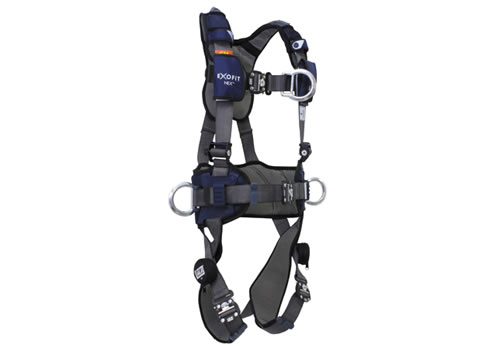Full Body Harness from Capital Safety Group The Full Body Harness - why putting it on is not enough Once it's been established that there is a requirement to work at height, the right work method and fall protection equipment then needs to be developed for the job at hand. A full body harness is one of the most crucial elements of someone's personal protective equipment (PPE): of everything that employees use, they will interact most frequently with the harness, whether donning, adjusting or inspecting it. However, it's not enough for the employer to simply ensure that staff wear the harnesses when working. Often, harnesses can be extremely uncomfortable if they are not worn correctly or adjusted properly, and this can put the fall arrest effectiveness at risk for the user. In addition, proper inspections should highlight in advance those harnesses that can no longer be used due to wear and tear. Harness Evolution Harnesses have come a long way since the linesman's 'body belt', worn in the early 1900s around users' waists for pole climbing. These forerunners of today's full body harnesses were at best better than nothing, only providing some protection to arrest falls if the worker happened to fall 'correctly'. The belts offered no impact or shock protection from impact forces to the body. Worse still, they rarely fitted correctly, meaning that workers often fell out of the belts which were too loose. Accidents led to the development of the first height safety full body harness, designed initially with the objective of better distributing fall arrest forces and minimising the chance of the worker falling out of the system. Developed in the 1940s and modeled on the military parachute harness, this harness did distribute fall arrest forces more evenly but still fell way short of perfect. The bulky and heavy materials used in its construction proved to be very cumbersome and hard to don and wear, leading to a lack of widespread use. In time, developments moved on to triangular and X-fit style harnesses. These were easier to don, as they fell in place by simply grasping the dorsal D-ring. The first harness with comfortable features such as soft edging and padding was not developed until 2001. Designed in the mould of a recreational harness, this comfort harness used durable materials and included features such as five points of adjustment, a 'stand-up' dorsal D ring and quick connect buckles to aid donning and achieve a good fit. Today's fall protection harnesses have evolved to include features designed for specific industries. As long as the harness is comfortable and does not restrict a worker's movement, he will choose to wear it in order to protect his safety. This is particularly important in companies where there is not a large safety culture and no clear procedures for operator training. If a worker feels that he cannot do his job as well when encumbered by a body harness then he will not wear it unless he is forced to. The right fit Only a properly fitted harness will ensure the right distribution of fall arrest forces to the appropriate regions of the body. In the event of a fall, if the harness is too loose, the uneven distribution of forces throughout the body could exert dangerous pressure on certain areas. Movement of the sub-pelvic strap can lead to serious injury for male workers, and if the chest strap is loose it can cause the shoulder straps to fall of the shoulders. A harness that is not not correctly adjusted can cause a choking hazard in the event of a fall. Any loose straps could also prove hazardous if caught on moving or heavy equipment. Fall protection harnesses that are too tight also lead to the improper distribution of fall arrest forces in the event of a fall, as well as extreme discomfort and loss of circulation. As a general rule, if the user is able to just make a fist in between his body and one of the harness straps when wearing the harness, then it is a snug and proper fit. Top 5 Most Important Fall Protection Full Body Harness Features
1. Comfort
2. Adjustability
3. Ease of donning and use
5. Customisation
Height Safety Harness fitting and inspection
1. Hardware
2. Webbing Inspection
3. Label inspection
4. Subsystem Components
5. Record keeping The manufacturer's instruction manual also includes information on how to adjust and don the harness. Capital Safety has developed instructional posters on how to properly don and inspect a harness, along with inspection and maintenance guidelines and checklists. These tools are available at no cost from the company's website at www.capitalsafety.com.au. In summary, it's not enough just to make full bodyharnesses safe. Employers and workers need to keep abreast of improvements in the fall protection industry to ensure the best possible customisation for harness users. Up-front investment in a premium harness will help to reduce the overall cost of any company's fall protection program, but the ultimate cost of not wearing the correct harness could be far more than financial. For further information on issues contained within this article or any other, please contact Capital Safety on 1800 245 002 (AUS) 0800 212 505 (NZ) or visit www.capitalsafety.com.au.
|
1800 024 464 Building A, 1 Rivett Rd, North Ryde, NSW, 2113
|


 Fall Arrest Anchorage Connectors from 3M
Fall Arrest Anchorage Connectors from 3M Commercial & Industrial Fall Protection
Commercial & Industrial Fall Protection Personal Protective Equipment Trade-Up
Personal Protective Equipment Trade-Up Safety Gear and Accessories Sydney from
Safety Gear and Accessories Sydney from Worker Health and Safety Video | 3M
Worker Health and Safety Video | 3M Truss Mounted Roof Anchor | 3M Safety
Truss Mounted Roof Anchor | 3M Safety Full Body Harness Range | 3M Safety
Full Body Harness Range | 3M Safety Portable Roof Anchor by DBI-SALA | 3M
Portable Roof Anchor by DBI-SALA | 3M 5-Piece Hoist System for Confined Space
5-Piece Hoist System for Confined Space ExoFit STRATA™ Harness Video | 3M
ExoFit STRATA™ Harness Video | 3M Full Body Safety Harness ExoFit STRATA |
Full Body Safety Harness ExoFit STRATA | Mechanical Prusik Rope-Mate™ | 3M
Mechanical Prusik Rope-Mate™ | 3M Comfort Harnesses for Fall Protection |
Comfort Harnesses for Fall Protection | Personal Self Retracting Lifelines | 3M
Personal Self Retracting Lifelines | 3M Fall Protection for Tools Video | 3M
Fall Protection for Tools Video | 3M Extended Length Self Retractable
Extended Length Self Retractable Engineered Mobile Access Systems | 3M
Engineered Mobile Access Systems | 3M Minimising Risks with Fall Prevention
Minimising Risks with Fall Prevention Double Stop Descenders | 3M Safety
Double Stop Descenders | 3M Safety Sealed Self Retrating Lifelines
Sealed Self Retrating Lifelines
